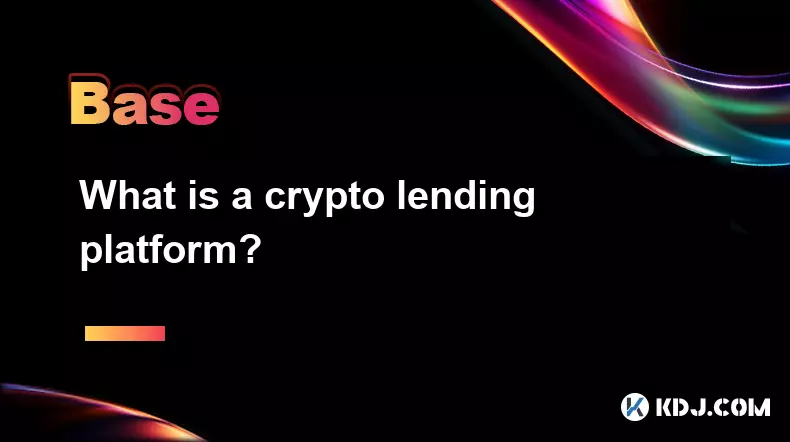-
 bitcoin
bitcoin $109547.008142 USD
0.04% -
 ethereum
ethereum $4011.838726 USD
-0.05% -
 tether
tether $1.000402 USD
-0.01% -
 xrp
xrp $2.798606 USD
0.88% -
 bnb
bnb $970.877944 USD
1.39% -
 solana
solana $202.237275 USD
-0.95% -
 usd-coin
usd-coin $0.999673 USD
0.00% -
 dogecoin
dogecoin $0.229294 USD
-1.15% -
 tron
tron $0.336370 USD
-0.45% -
 cardano
cardano $0.777260 USD
-1.66% -
 hyperliquid
hyperliquid $45.503019 USD
1.73% -
 ethena-usde
ethena-usde $1.000362 USD
0.01% -
 chainlink
chainlink $20.785303 USD
-1.10% -
 avalanche
avalanche $28.755822 USD
-0.11% -
 stellar
stellar $0.358303 USD
-0.48%
What is a crypto lending platform?
Crypto lending platforms let users earn interest by lending digital assets, with borrowers providing over-collateralized crypto, but risks include volatility, hacks, and regulatory uncertainty.
Sep 11, 2025 at 07:54 pm

Understanding Crypto Lending Platforms
A crypto lending platform is a digital service that allows users to lend their cryptocurrency holdings to borrowers in exchange for interest payments. These platforms operate on blockchain technology and often use smart contracts to automate the lending and borrowing process. Unlike traditional financial institutions, crypto lending platforms function in a decentralized or semi-centralized manner, offering faster access to capital and higher yields for lenders.
Users deposit their digital assets into a platform’s liquidity pool, where they are made available to borrowers. In return, lenders earn interest over time, typically paid in the same cryptocurrency they deposited. Borrowers, on the other hand, provide collateral—usually in the form of other cryptocurrencies—to secure loans. This collateralization helps mitigate default risk in a space where credit checks are not standard practice.
How Crypto Lending Works
- Lenders deposit supported cryptocurrencies such as Bitcoin (BTC), Ethereum (ETH), or stablecoins like USDT or DAI into a lending protocol.
- The platform pools these deposits and uses them to fund loans to borrowers who need liquidity.
- Borrowers must lock up collateral worth more than the loan amount, usually at ratios ranging from 125% to 200% depending on the asset’s volatility.
- Interest rates are determined algorithmically based on supply and demand dynamics within the platform.
- Lenders receive periodic interest payouts, while borrowers repay the principal plus interest to reclaim their collateral.
Types of Crypto Lending Models
- Centralized Lending Platforms: Operated by companies like Celsius (before its collapse) or Nexo, these platforms manage user funds directly and offer fixed or variable interest rates. They often provide customer support and additional services such as credit lines or debit cards.
- Decentralized Lending Protocols: Built on blockchains like Ethereum or Solana, protocols such as Aave, Compound, and MakerDAO allow peer-to-contract lending without intermediaries. Users interact with smart contracts directly through wallets like MetaMask.
- Peer-to-Peer (P2P) Lending: Platforms like Bitbond or YouHodler enable direct lending between individuals, matching lenders and borrowers based on terms they set. These models offer more customization but may carry higher counterparty risk.
Risks Associated with Crypto Lending
- Smart contract vulnerabilities can lead to exploits, resulting in loss of funds. Several high-profile hacks have occurred on both centralized and decentralized platforms.
- Collateral values fluctuate rapidly. If the price of a borrower’s pledged crypto drops below a threshold, the system may liquidate the collateral automatically, sometimes at a loss.
- Regulatory uncertainty looms over many platforms. Authorities in jurisdictions like the U.S. have taken action against certain lending products for violating securities laws.
- Liquidity risks arise when platforms restrict withdrawals during market stress, as seen during the 2022 crypto winter with firms like BlockFi and Voyager Digital.
- Default risk exists even with over-collateralization, especially if multiple positions are liquidated simultaneously during extreme volatility.
Frequently Asked Questions
What happens if a borrower defaults on a crypto loan?In most cases, the borrower’s collateral is automatically liquidated by the platform to cover the outstanding debt. On decentralized platforms, this process is handled by smart contracts, ensuring timely execution without human intervention.
Are crypto lending earnings taxable?Yes, in many countries, interest earned from crypto lending is considered taxable income. Tax treatment varies by jurisdiction, with some treating it as ordinary income and others applying capital gains rules upon withdrawal or conversion.
Can I lend any cryptocurrency?No, only specific tokens supported by the platform can be lent. Major platforms typically accept BTC, ETH, and popular stablecoins. Less common altcoins may not be eligible due to volatility or low demand.
Do I retain ownership of my crypto while it's being lent?Ownership depends on the platform. In decentralized protocols, users maintain control via their wallet. In centralized models, the platform holds custody, meaning users trust the operator to safeguard and return their assets.
Disclaimer:info@kdj.com
The information provided is not trading advice. kdj.com does not assume any responsibility for any investments made based on the information provided in this article. Cryptocurrencies are highly volatile and it is highly recommended that you invest with caution after thorough research!
If you believe that the content used on this website infringes your copyright, please contact us immediately (info@kdj.com) and we will delete it promptly.
- Digital Asset Treasuries, M&A, and the Crypto Berkshire Hathaway: A New Era
- 2025-09-29 02:25:14
- DeepSnitch AI: Your Crypto Fortune Teller for 2025?
- 2025-09-29 02:25:14
- BlockchainFX, Dogecoin, and Crypto Coins: A New York Minute on the Future
- 2025-09-29 02:30:01
- Pepe Price Prediction: Will the Bull Cycle Send PEPE to the Moon?
- 2025-09-29 02:30:01
- Solana Price, Wrapped Bitcoin, and Cyber Hornet ETF: Decoding the Hype
- 2025-09-29 02:30:01
- MoonBull Meme Coin Presale Buzz: The Next Big Crypto Stampede?
- 2025-09-29 02:30:13
Related knowledge

What are some common methods of cryptocurrency market manipulation?
Sep 27,2025 at 02:55am
Wash Trading and Its Impact on Market Perception1. Wash trading involves an individual or entity simultaneously buying and selling the same cryptocurr...

How do I read a cryptocurrency whitepaper?
Sep 27,2025 at 05:54am
Understanding the Structure of a Cryptocurrency Whitepaper1. Begin by identifying the executive summary, which outlines the project’s core vision and ...

Can I recover lost cryptocurrency?
Sep 25,2025 at 08:18am
Understanding the Nature of Cryptocurrency Loss1. Cryptocurrency operates on decentralized networks, meaning there is no central authority to reverse ...

How do I choose a cryptocurrency investment strategy?
Sep 27,2025 at 03:55pm
Understanding Risk Tolerance in Crypto Investing1. Assessing personal risk tolerance is a foundational step when entering the cryptocurrency market. V...

How can I earn passive income from cryptocurrency?
Sep 23,2025 at 10:18am
Staking Cryptocurrencies for Regular Returns1. Many blockchain networks operate on a proof-of-stake (PoS) consensus mechanism, allowing users to earn ...

How can cryptocurrency be used for cross-border payments?
Sep 28,2025 at 01:36am
Efficiency in International Transactions1. Cryptocurrency enables near-instant settlement across borders without relying on traditional banking interm...

What are some common methods of cryptocurrency market manipulation?
Sep 27,2025 at 02:55am
Wash Trading and Its Impact on Market Perception1. Wash trading involves an individual or entity simultaneously buying and selling the same cryptocurr...

How do I read a cryptocurrency whitepaper?
Sep 27,2025 at 05:54am
Understanding the Structure of a Cryptocurrency Whitepaper1. Begin by identifying the executive summary, which outlines the project’s core vision and ...

Can I recover lost cryptocurrency?
Sep 25,2025 at 08:18am
Understanding the Nature of Cryptocurrency Loss1. Cryptocurrency operates on decentralized networks, meaning there is no central authority to reverse ...

How do I choose a cryptocurrency investment strategy?
Sep 27,2025 at 03:55pm
Understanding Risk Tolerance in Crypto Investing1. Assessing personal risk tolerance is a foundational step when entering the cryptocurrency market. V...

How can I earn passive income from cryptocurrency?
Sep 23,2025 at 10:18am
Staking Cryptocurrencies for Regular Returns1. Many blockchain networks operate on a proof-of-stake (PoS) consensus mechanism, allowing users to earn ...

How can cryptocurrency be used for cross-border payments?
Sep 28,2025 at 01:36am
Efficiency in International Transactions1. Cryptocurrency enables near-instant settlement across borders without relying on traditional banking interm...
See all articles









































































